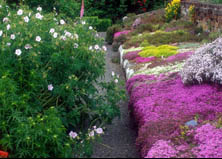'Fireglow' colour and more on the contorted hazel
 There's a bit of warmth in the sun today and the birds are responding with activity - blackbirds singing, goldfinches busy on the feeder, a wren darting about in and out of bushes, the lazy sound of pigeons crooning in the pines. Snowdrops and aconites are in flower, the first fresh leaves of wild garlic are pushing through the leaf litter in the woods and dark red hellebores are in fullsome bud. But one of the earliest herbaceous plants to push through the soil is Euphorbia griffithii 'Fireglow', looking jewelled when the light shines behind it, its overlapping leaves a mixture of soft jade green and vivid pink. There are several times in the year when you are repaid for allowing this vigorous plant into a border and now is one of them. The buds are joyful and a rich colour for January.
There's a bit of warmth in the sun today and the birds are responding with activity - blackbirds singing, goldfinches busy on the feeder, a wren darting about in and out of bushes, the lazy sound of pigeons crooning in the pines. Snowdrops and aconites are in flower, the first fresh leaves of wild garlic are pushing through the leaf litter in the woods and dark red hellebores are in fullsome bud. But one of the earliest herbaceous plants to push through the soil is Euphorbia griffithii 'Fireglow', looking jewelled when the light shines behind it, its overlapping leaves a mixture of soft jade green and vivid pink. There are several times in the year when you are repaid for allowing this vigorous plant into a border and now is one of them. The buds are joyful and a rich colour for January.
I had a comment from Merlotti on my last but one posting, requesting more information on the contorted hazel, so I am adding a postscript to that one. A long time ago I read a biography of that wonderful, generous gardener, E A Bowles, and one of the many things that stuck in my mind was his love of the eccentric plant. At his garden of Myddelton House, north of London, he enjoyed growing some of the oddities of the plant world in what he termed his 'lunatic asylum'. A hazel that was growing in an unusual way in a Gloucestshire hedge in the 1860's was noticed by a Victorian gardener, Canon Ellacombe, and knowing that its quirkiness would delight his friend, E A Bowles, he took cuttings and propagated it. This original plant is still growing at Myddelton House. In the early 20th century it became known as Harry Lauder's walking stick after the Scottish entertainer who had a twisted walking stick, but this name was attached some decades after it was first discovered.
Although it is relatively slow-growing, it can take up quite a bit of room when mature, technically up to 15ft high though most large specimens I have seen are usually about 8-10, and there needs to be enough room for its crazy, squiggling branches. It is sad, as with so many shrubs, when it is planted in too small a space, because it is a shame to prune the madness out of its shape just to make it fit. Because it is at its best in winter, the summer leaves not being very attractive, it can be planted with tall herbaceous plants in front that will grow up and hide it later - for example, fennel, cardoon, asters, joe pye weed or tall grasses. Hope this is the information you wanted, Merlotti - I got rather carried away!!



